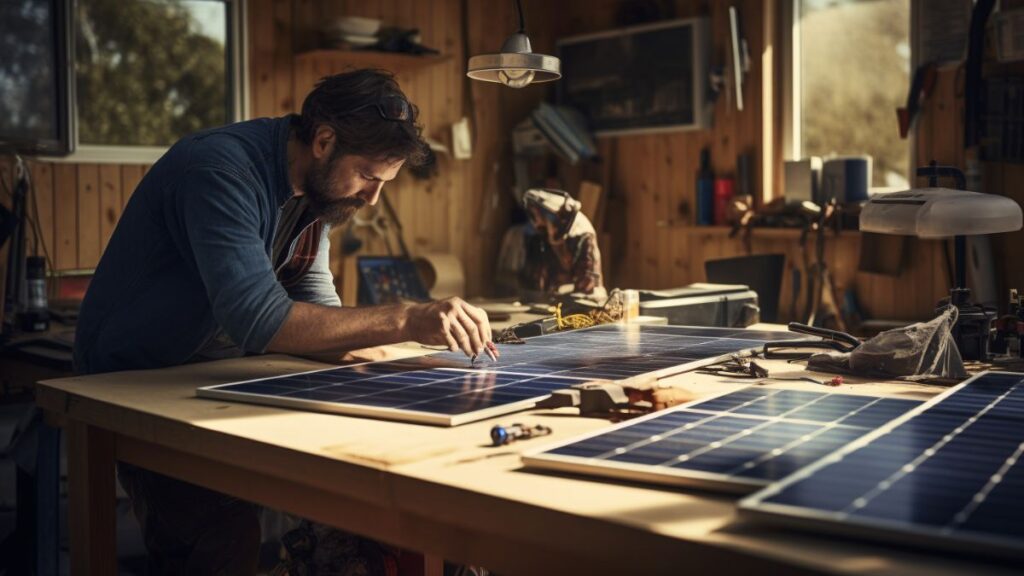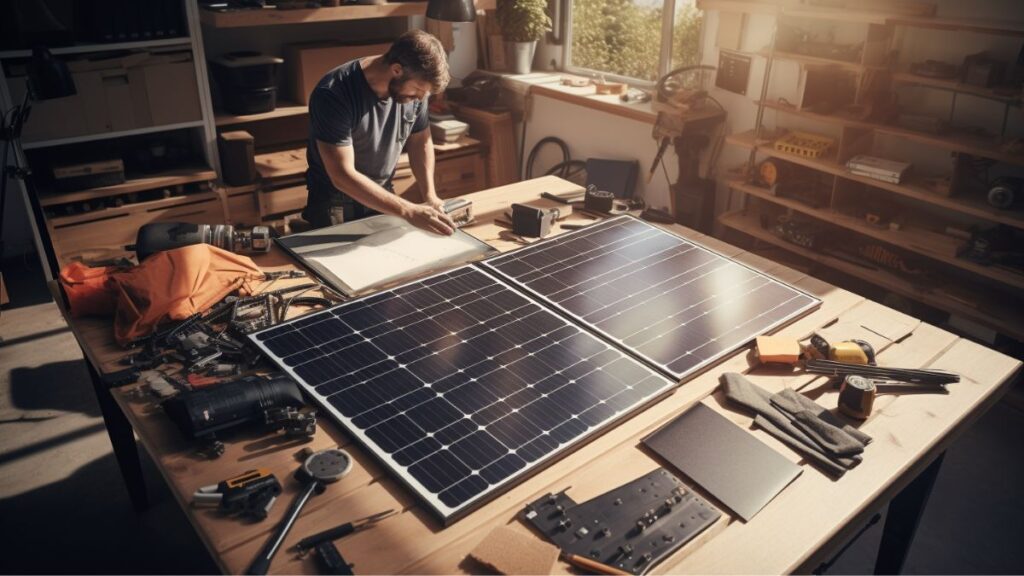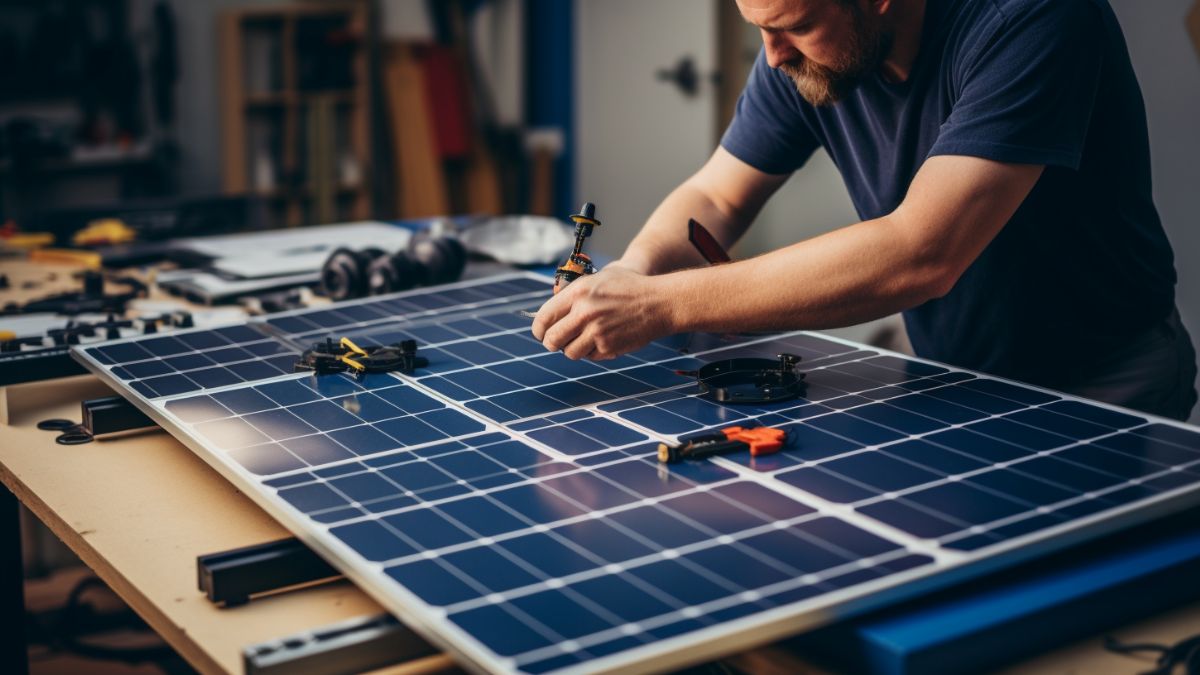Are you ready to harness the power of the sun and take control of your energy consumption? Look no further! In this comprehensive guide, we will explore the pros and cons of DIY solar panels, providing you with the knowledge and tools to create your very own renewable energy source.
Like a key to a secret garden, this article will unlock the secrets of solar panel production, testing, and sizing. We’ll also discuss the potential risks and considerations involved, ensuring you have all the information you need to embark on your solar journey. Join us as we explore the world of DIY solar panels and discover the power of the sun at your fingertips.

Key Takeaways
- Harnessing the power of the sun for energy consumption is the main advantage of DIY solar panels.
- Creating your own renewable energy source can lead to cost savings and contribute to a greener environment.
- DIY solar panels have limitations, including limited power output and efficiency compared to professional systems, safety concerns, and potential long-term maintenance costs.
- When choosing materials for DIY solar panels, factors such as cost, environmental impact, durability, and efficiency should be considered.
How To Make Solar Panels

If you’re considering making your own solar panels, there are several key points you should be aware of.
First, thorough research and planning are essential to ensure you understand the process and requirements. Next, sourcing the ideal materials is crucial for the efficiency and longevity of your panels. Additionally, obtaining proper permitting is necessary to comply with local regulations.
While DIY solar panels are recommended for small projects, it’s important to note that they may not be suitable for home use due to safety and reliability concerns.
Research and Planning
Before diving into a DIY solar panel project, it’s crucial to thoroughly research and plan. This includes taking into account factors like location, available sunlight, and energy requirements.
Conducting thorough research benefits you in several ways. Firstly, it allows you to understand the feasibility and potential benefits of installing solar panels in your specific area. By conducting a cost analysis, you can determine the financial implications and potential savings of a DIY project.
Additionally, taking the time to plan the process ensures that you have a clear understanding of the necessary steps and materials required. It also helps you evaluate the time commitment involved, allowing you to plan accordingly.
Lastly, researching and planning ahead can help you anticipate potential challenges and develop strategies to overcome them, ensuring a smoother DIY solar panel project.
Sourcing Ideal Materials
To find the best materials for your solar panel project, start by researching reputable suppliers and comparing prices and customer reviews. Sourcing materials is crucial for the success of your DIY solar panel project. Here are some key considerations to keep in mind:
- Cost considerations: Look for suppliers with competitive prices without compromising quality. Consider the overall cost of materials, including additional expenses like shipping or taxes.
- Quality control: Choose suppliers that prioritize quality control measures to ensure materials meet industry standards and perform effectively in your solar panel.
- Environmental impact: Consider the environmental impact of the materials you choose. Look for suppliers offering eco-friendly options, such as solar panels made from recycled materials or with a lower carbon footprint.
- Alternative options: Explore alternative options for sourcing materials, like local suppliers or online marketplaces. This can help you find unique or hard-to-find materials while supporting local businesses.
By considering these factors, you can source ideal materials for your DIY solar panel project that are cost-effective, high-quality, environmentally friendly, and easily accessible.
Obtaining Proper Permitting
Obtaining the necessary permits is essential for ensuring compliance with local regulations and avoiding any potential legal issues when installing DIY solar panels. The permitting process involves fulfilling legal requirements and adhering to building codes set by local authorities. This step is crucial as it ensures the safety and quality of your solar panel installation. To make it easier for you, here is a table summarizing the key steps in the permitting process:
| Permitting Process Steps | Description | Benefits |
|---|---|---|
| 1. Research local regulations | Understand the specific requirements and guidelines set by your local government. | Avoid penalties and fines by complying with regulations. |
| 2. Fill out permit application | Complete the necessary paperwork, including detailed plans and specifications. | Ensure your installation meets all safety and quality standards. |
| 3. Pay permit fees | Submit the required fees along with your application. | Support local authorities in maintaining infrastructure and services. |
| 4. Schedule inspections | Arrange for inspections at various stages of the installation process. | Ensure your system is safe, functional, and meets all requirements. |
| 5. Obtain final approval | Once all inspections are passed, receive official approval for your solar panel installation. | Enjoy peace of mind knowing your system is legally compliant and safe. |
By following the permitting process and obtaining approval, you can confidently install your DIY solar panels while adhering to local regulations and building codes. This not only ensures the safety and quality of your installation but also contributes to the well-being of your community.
Recommended for Small Projects
If you’re working on small projects, it’s recommended to consider the advantages of using DIY solar panels. These panels are specifically designed for small-scale applications and can offer numerous benefits.
Firstly, they are cost-effective, allowing you to save money on your energy bills in the long run.
Additionally, DIY solar panels are highly energy efficient, converting sunlight into usable electricity with minimal loss. This not only helps reduce your carbon footprint but also contributes to a cleaner and greener environment.
Furthermore, DIY solar panels have low maintenance requirements, making them an ideal choice for small projects where time and resources may be limited.
By opting for DIY solar panels, you can harness the power of the sun in a way that is both practical and sustainable for your small-scale endeavors.
Not Recommended for Home Use
Although DIY solar panels may be suitable for small projects, they are not recommended for home use due to various limitations and potential risks.
When considering installing solar panels for your entire home, it is important to weigh the pros and cons. DIY solar panels come with certain limitations, such as limited power output and efficiency compared to professionally installed systems.
Safety concerns are also a major factor to consider, as improper installation or maintenance can lead to electrical hazards. Additionally, DIY solar panels may not be as cost-effective in the long run, as they may require more frequent maintenance and replacement parts.
Lastly, the environmental impact of DIY solar panels may not be as significant as professionally installed systems, as they may not meet the same standards of energy efficiency. To better understand these limitations, refer to the table below:
| Limitations | Safety Concerns | Cost Effectiveness | Maintenance Requirements |
|---|---|---|---|
| Limited power output and efficiency compared to professionally installed systems | Improper installation or maintenance can lead to electrical hazards | May require more frequent maintenance and replacement parts | May not meet the same standards of energy efficiency |
Considering these factors, it is advisable to consult with professionals and consider the long-term benefits and potential risks before deciding to install DIY solar panels for your home.
Types and Production of Solar Panels
When it comes to solar panels, there are various types available for you to choose from. These include monocrystalline, polycrystalline, and thin-film solar panels. Each type has its own advantages and disadvantages, so it’s important to understand the differences before making a decision.
Different materials are used in the production of solar panels, such as silicon, cadmium telluride, and copper indium gallium selenide.
The steps involved in the production of solar panels include the creation of the solar cells, assembly of the panels, and testing for quality assurance.
Available Types
There are three main types of solar panels: monocrystalline, polycrystalline, and thin film. Each type has its own advantages and disadvantages.
Monocrystalline panels are known for their high efficiency and sleek appearance. They are more expensive than the other two types but offer better performance in low-light conditions.
Polycrystalline panels, on the other hand, are less expensive and have a slightly lower efficiency. They are a popular choice for residential installations.
Thin film panels are the least expensive but also the least efficient. They are flexible and lightweight, making them suitable for certain applications such as solar-powered gadgets.
When it comes to installation, monocrystalline and polycrystalline panels require a standard mounting system, while thin film panels can be easily integrated into building materials.
As for maintenance, all types of solar panels require minimal upkeep, such as regular cleaning to remove dirt and debris.
Different Materials Used
Mono silicon, polysilicon, and amorphous silicon are the various materials used in solar panel production. Each material has its own advantages and disadvantages.
- Mono silicon: This material is made from a single, high-purity crystal structure, making it the most efficient option. However, it is also the most expensive due to the complex manufacturing process.
- Polysilicon: This material is made from multiple small silicon crystals, which makes it less efficient than mono silicon. However, it is more cost-effective, making it a popular choice for residential solar panels.
- Amorphous silicon: This material is non-crystalline, which means it can be deposited on flexible substrates. It is less efficient than mono and polysilicon, but it is more affordable and suitable for applications where flexibility is required.
When choosing a material for DIY solar panels, cost considerations, environmental impact, durability factors, and efficiency measures should all be taken into account. Consider your budget, the environmental impact of the material, how long it will last, and how efficient it will be in converting sunlight into electricity.
Steps in Production
The first step in the production of solar panels is converting sand into silicon. This involves several steps, including purification, melting, and crystallization.
Once the silicon is formed, it is shaped into ingots, which are then sliced into thin wafers. These wafers are treated with various chemicals to enhance their conductivity and then coated with conductors, such as silver or aluminum.
The wafers are then soldered together to form solar cells. These cells are then assembled into panels, which can be connected to each other to create a larger solar system.
The production steps involved in making solar panels are complex and require specialized equipment and expertise. However, the building process is well-documented and can be followed by DIY enthusiasts.
It is important to note that while DIY solar panels can be cost-effective, they may not have the same level of energy efficiency and may require more maintenance compared to professionally manufactured panels. A cost analysis should be done to determine the best option for each individual’s needs.
| Pros | Cons |
|---|---|
| Cost-effective | Lower efficiency |
| DIY satisfaction | Increased maintenance |
| Customization options | Lack of warranty |
In conclusion, the production of solar panels involves several steps, starting from converting sand into silicon to assembling the panels. While DIY solar panels offer cost savings and customization options, they may have lower efficiency and require more maintenance. It is important to weigh the pros and cons before deciding on the best option for your energy needs.
Sizes and Testing of Solar Panels
In this discussion, we will explore the different sizes and testing process of solar panels.
When it comes to sizes, solar panels can vary in dimensions and wattage output, allowing you to choose the most suitable option for your energy needs.
Additionally, we will delve into the testing process, which ensures that solar panels meet quality and performance standards, giving you confidence in their efficiency and durability.
Different Sizes
When choosing the right size for your specific energy needs, consider the different configurations of solar panels. These include 48-cell, 60-cell, and 72-cell panels. Each size has its own advantages and disadvantages, so it’s important to understand the customization options available to you.
- Customization options: Different sizes allow for flexibility in designing a solar system that fits your specific space and energy requirements.
- Efficiency comparison: Larger panels generally have higher power output, but smaller panels may be more efficient in certain situations.
- Cost effectiveness analysis: The cost of solar panels can vary depending on their size, with larger panels typically being more expensive. However, larger panels may also provide a better return on investment over time.
- Maintenance requirements: Smaller panels are generally easier to maintain and replace if needed.
- Environmental impact: Larger panels require more materials, which can have a greater environmental impact during production. However, their higher power output may result in a smaller carbon footprint over time.
Consider these factors when choosing the size of your solar panels to ensure you make an informed decision that meets your energy needs while considering efficiency, cost, maintenance, and environmental impact.
Testing Process
To ensure the efficiency and performance of your solar panels, it’s essential to understand the testing process. Testing techniques play a crucial role in the performance evaluation, quality control, efficiency measurements, and reliability assessment of solar panels.
One common testing method is the use of Standard Test Conditions (STC), which involve exposing the panels to a specific set of conditions to measure their performance accurately. Another method is the flash tester, which uses a flash of light to simulate sunlight and measure the electrical output of the panels.
Additionally, spec sheets provide valuable information about the panel’s specifications and performance. Lastly, the Nominal Operating Cell Temperature (NOCT) test determines the temperature at which the panel operates and evaluates its performance under those conditions.
Understanding these testing methods is essential for ensuring that your DIY solar panels are efficient and reliable.
DIY Solar Panels and Risks

When it comes to DIY solar panels, there are a few key points to consider.
First, there is the possibility of building them from scratch, which can be a rewarding and cost-effective option. However, it’s important to weigh the pros and cons, as there can be risks involved.
Lastly, you’ll want to assess the suitability of DIY solar panels for your specific needs and circumstances.
Possibility of Building from Scratch
If you’re considering building your own solar panels from scratch, you’ll need to assess the level of expertise and skills required for successful construction. Building DIY solar panels involves a combination of technical knowledge, manual dexterity, and attention to detail. Here are some factors to consider:
- Building Techniques: You’ll need to understand the different building techniques involved, such as soldering cells together, wiring connections, and sealing the panel. It’s important to research and follow proper construction methods to ensure the panel functions efficiently and safely.
- Cost Effectiveness: DIY solar panels can be cost-effective compared to buying pre-made ones. However, it’s essential to evaluate the upfront costs of materials and equipment needed for construction.
- Energy Efficiency: Properly designed and built solar panels can generate a significant amount of electricity. Understanding the principles of solar energy and panel efficiency is crucial for maximizing energy production.
- Environmental Impact: DIY solar panels can contribute to a more sustainable future by reducing reliance on fossil fuels. However, it’s important to consider the environmental impact of the materials used and disposal methods for old or damaged panels.
- Maintenance Requirements: Regular maintenance, such as cleaning the panels and checking for any damage, is necessary to ensure optimal performance and longevity of DIY solar panels. Familiarize yourself with the maintenance requirements to keep the panels functioning effectively.
Building your own solar panels from scratch can be a rewarding and cost-effective endeavor. However, it requires a certain level of expertise and skills to ensure successful construction and long-term functionality.
Pros
Building your own solar panels offers the opportunity for cost savings and customization options to meet your unique energy needs and aesthetic preferences. One of the main pros of DIY solar panels is the potential for significant cost savings. By sourcing and assembling the materials yourself, you can avoid the markups associated with pre-made solar panels and installation services.
Additionally, building your own solar panels allows you to customize the system to suit your specific energy requirements. Whether you need to power a small shed or an entire home, you can design the system accordingly.
Furthermore, the ability to choose the appearance and design of your solar panels provides an opportunity to enhance the aesthetic appeal of your property.
However, it’s important to consider the risks and suitability before embarking on a DIY solar panel project. Building from scratch requires a certain level of technical knowledge and skill, and it’s crucial to have the necessary resources and guidance to ensure a successful outcome.
Cons
To fully understand the risks and challenges involved, you should be aware that finding quality materials for your DIY solar panel project may be difficult. Here are four important factors to consider:
- DIY solar panel efficiency: Unlike professionally manufactured panels, DIY panels may not be as efficient in converting sunlight into electricity. This means you might not generate as much energy as you hoped for.
- Cost effectiveness: While DIY solar panels can save you money on installation costs, they may not be as cost-effective in the long run. The initial investment for high-quality materials can be expensive, and the lower efficiency could result in lower savings on your energy bills.
- Environmental impact: DIY solar panels require the use of materials that may not be environmentally friendly. Additionally, if the panels are not installed correctly or maintained properly, they could contribute to environmental pollution.
- Safety concerns and maintenance requirements: DIY solar panels pose a greater risk of system failure and potential safety hazards. Without professional installation and regular maintenance, there is a higher chance of electrical faults or fires.
Considering these factors, it is crucial to weigh the pros and cons before embarking on a DIY solar panel project.
Suitability
The suitability of DIY solar panel installations should be carefully considered.
While DIY solar panels can be a cost-effective option, it is important to recognize their limitations when it comes to whole-house installations.
One key consideration is the environmental impact. DIY solar panels may not have the same level of energy efficiency as professionally installed systems, resulting in lower overall energy savings.
Additionally, maintenance requirements can be higher for DIY installations, as they may not have the same level of durability and reliability as professionally installed systems.
Furthermore, the installation process for DIY solar panels can be complex and time-consuming, requiring a significant amount of technical knowledge and skills.
It is essential to weigh the cost effectiveness, environmental impact, energy efficiency, maintenance requirements, and installation process before deciding on a DIY solar panel installation.
Considerations and Resources
When considering DIY solar panels, there are a few key points to keep in mind.
First, you need to think about where you will source your equipment from. It’s important to find reputable suppliers that offer high-quality materials to ensure the efficiency and longevity of your solar panels.
Additionally, having access to detailed guides and resources is essential for successfully completing the project. These guides will provide step-by-step instructions, tips, and troubleshooting advice to help you navigate the process with confidence.
Considerations for Sourcing Equipment
One important consideration for sourcing equipment is researching reputable brands and comparing prices. When it comes to equipment quality, it is crucial to choose brands that have a proven track record in the industry. This ensures that you are investing in reliable and durable components for your solar panels.
Additionally, comparing prices allows you to find the best deal that fits within your budget constraints. Remember to take into account the long-term cost-effectiveness of the equipment, as well as the potential environmental impact. Safety precautions should also be a priority, so be sure to choose suppliers that prioritize safety standards.
Lastly, supplier reliability is key to ensure that you receive your equipment on time and in good condition.
Considerations for sourcing equipment:
- Research reputable brands
- Compare prices
- Assess equipment quality
- Evaluate environmental impact
- Ensure supplier reliability
Resources for Detailed Guides
Now that you have considered where to source your equipment, it’s time to explore the resources available to guide you through the process of making your own solar panels.
When it comes to detailed guides and reliable sources, there are a few online platforms that stand out. Websites like instructables.com, wikiHow.com, and thosesolarguys.com offer comprehensive step-by-step instructions, informative articles, and even instructional videos to help you along the way.
These resources provide a wealth of knowledge, covering everything from materials needed to the assembly process, making it easier for beginners to grasp the concepts involved.
Whether you prefer written tutorials or visual aids, these platforms have you covered, ensuring that you have access to the information and guidance you need to successfully create your own solar panels.
Conclusion
In conclusion, making your own solar panels can be a rewarding and cost-effective endeavor. By following the steps outlined in this guide, you can create your own renewable energy source and potentially save money on electricity bills.
However, it’s important to weigh the pros and cons before embarking on this DIY project. While it can be a great learning experience and help reduce your carbon footprint, there are also risks involved, such as improper installation or voiding warranties.
Remember the adage ‘measure twice, cut once’ and carefully consider your resources and abilities before diving into DIY solar panel production.
If you are looking for a step-by-step course that teaches you how to lower your energy bills and become more energy independent and self-sufficient by building your own power at home with professional quality solar panels then this is the right system that you can count on.




